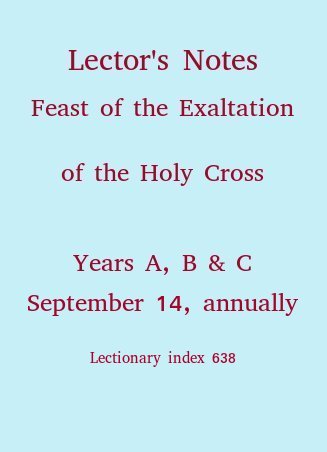

Exaltation of the Holy Cross, September 14, annually
For a beaten-down people, just returned to Judah after sixty years of exile, their priests retell an encouraging story of greatness from their dimly remembered past. The story also suggests an orthodox takeover of a pagan custom, which has sometimes proven a smart strategy.
Saint Paul loved the Christians at Philippi, and was encouraged by their embrace of Christ. Here he quotes for them the earliest known hymn about the mystery of Christ.
Saint John's gospel aims to help indecisive persecuted Christians make a commitment to Christ and keep the faith. Here the evangelist shows Jesus explaining what is most hard for a believer to understand.
The Historical Situation: The Book of Numbers tells parts of the story of the Hebrews' journey from Egypt to the Promised Land, events that happened in the 13th century B.C.E. But the book as we have it was written much later. In the early 6th century B.C.E., the descendants of those earlier settlers were invaded and defeated, and many were taken as captives to Babylon. Their sixty years there are known as the Exile. When they finally got to return to their homeland, by then known as Judah, their priests wanted to help restore the nation. One of their methods was to revive a sense of the people's more glorious early history, so they retold a number of ancient stories from the time of Moses, producing what we now know as the Book of Numbers.
(Click here for a very compressed history (250 words) of the Israelite people, from Abraham, through the Exodus, then the Exile, up to the time of Jesus.)
Now this one is a strange story. In the first place, archaeologists have found small copper snakes, dating from the 13th century, in the area described. They were presumably used to ward off real snakes. But that the Lord would order the creation of a serpent statue on a staff doesn't square at all with "Thou shall make no graven images," the cornerstone of Mosaic monotheism. So why didn't the 6th-century editors just leave out this embarrassing 700-year old story? Perhaps because the monotheistic victory had yet to be won. Perhaps people were still honoring snake statues on poles. They still had reason to fear snakes (even newborn chimpanzees are afraid of snakes), and if an old superstition from folk-religion promised some security, well, why not try it? If the orthodox couldn't eradicate the practice, they could try to take over its pagan religious origins, ascribing the practice to Moses acting on God's orders. It's kind of like making a virtue out of a necessity, not the most intellectually rigorous strategy, but a serviceable one in a religion of earthy human beings.
Your Proclamation: First of all, read it slowly and pronounce everything correctly. In the U.S.A., English-language lectors will have to say "saraph serpents" while those using the New Jerusalem Bible translation get to pronounce "fiery serpents." And clearly pronounce the Lord's directions about the serpent on the pole. You can't assume that your listeners already know this story or remember it from several years ago, so give them time to absorb the strange details. If you read quickly, you're implying that you take all these details for granted, as if they were the most ordinary things in the world. Well, they're not. They're strange. When you tell a strange story, you speak slowly and pause strategically to emphasize the strangeness of the narrative.
So tell it like a story, of course. Make the people sound worn out when they complain. In describing the Lord's matter-of-fact response, speak slowly and coldly. Emphasize "bit" and "died." And likewise emphasize the last word, "lived."
So the lector should prepare for this by savoring this text slowly and reverently. Notice the cycle:
Proclaiming It: The English translation available (in the commonly used lectionary among Catholics in the U.S.) doesn't seem poetic or worthy of singing. Until the right poet/musician comes along who can render the passage more beautifully, it's up to you speak it faithfully, with the solemnity that its venerable status calls for.
Addendum, 2025: I just remembered that the right musician may have come along in the early 1970's. Reconsider this: Jesus, the Lord by Roc O'Connor of the Saint Louis Jesuits, a setting of the Philippians hymn. This would be a great opening prayer for a community leadership meeting. Since Paul wrote this to a community, not just to a pious individual, leaders, having heard the hymn prayerfully, can ask how their community can reproduce the obedience -- dying -- being raised cycle as a community.
(Choir folk: This hymn is beautiful in 4 parts.)
Don't rush through this reading, either. I would pause at each transition from phase to phase of the cycle. Read the passage now with that in mind and decide where you will pause.
A crux gemmata ("jeweled cross") from the year 1,000. See an academic discussion of the object here, and an enlarged picture of it here.
The cameo of the emperor in the likeness of Augustus on the cross of Christ is shocking to me, utterly tasteless. But I share the whole thing because I don't want to forget that imperialists are never above misrepresenting religion for their own ends.
This page updated September 17, 2025.